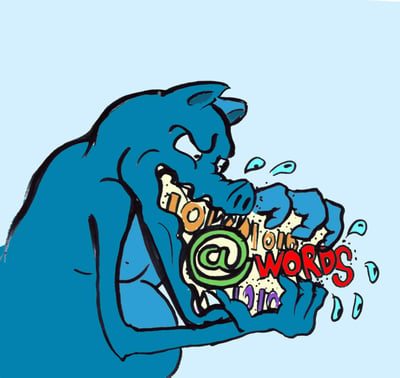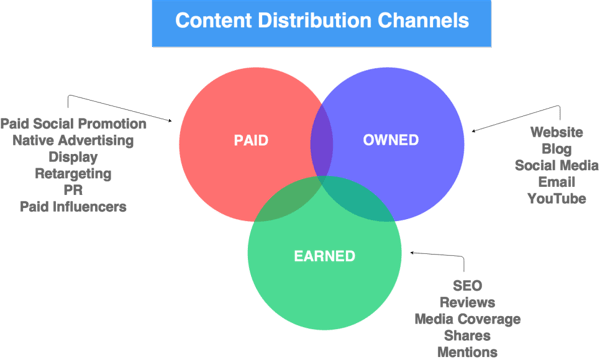Those of us who work in content are well acquainted with the “content beast.” Feeding the beast is an unavoidable part of the daily grind of content creation. It involves ideation, planning, production, editing, review, and revisions in order to ensure you have enough content for your blog, new product pages, email campaigns, and so on. It’s the beast that demands so much of our time and energy. This often leaves little head-space for an equally vital part of your content strategy—content distribution.
 Artist's rendition of the dreaded "content beast".
Artist's rendition of the dreaded "content beast".
Consider this. How effective can great content really be if nobody sees it?
"Content is king, but distribution is queen and she wears the pants. It’s not nearly enough to create a good piece of content. You have to understand how content spreads across the web."
–Jonathan Perelman, Buzzfeed"If a blog article is published on the internet, but no one reads it, does it really exist?"
– Unknown
Content Distribution Basics: Know Your Channels
Before discussing strategy, it’s important to know the three key media channels by which content is delivered: They are owned, earned, and paid.
Owned Media
Owned media are those channels where the brand can, for the most part, control the messaging and display. These include the brand’s web site, social media and content platforms such as Facebook, Twitter, YouTube, Pinterest, and Slideshare.
The main advantages of using owned media for distribution are control and cost. You determine what content you want displayed, and it costs nothing (aside from the time and resources in creating the content) to publish content on your site or on your managed social media and content platforms. However, it can be a labor intensive practice -- producing quality content isn’t easy, and you need to be publishing on a consistent basis. Also, it may take some time for these efforts to bear fruit.

Paid Media
Paid media is paid placement for your content. Some popular paid methods include paid social posts, PPC, press release distribution, paid influencers, and native advertising.
A well-executed paid campaign can lead to immediate and direct results. However, paid is not the best distribution strategy for all your content. It can be expensive. Also, there are many readers who find paid content to be less credible. Fifty-percent of college-educated readers are less likely to trust sponsored content according to a 2014 survey of U.S. web users.
Earned Media
Earned media is where your content receives recognition by non-paid means. Positive results due to SEO efforts are one example of distribution via earned media: Content appearing in natural (vs. paid) search results for desired queries or backlinks from relevant sites. Traditionally it is where the customers and influencers broadcast your content for you. In the digital space, this is done via social shares and mentions, reviews, and user generated content.
Content that is discovered via earned media distribution tends to appear more credible, than if the same message were delivered via earned or paid means. However, it is difficult to make happen, and you don’t necessarily have control of the slant of the message (positive vs negative).
Content Distribution Strategy: Tips on Getting Started
Produce fantastic content
Content still comes first. You need to create content that supports your business goals, as well as provides value to the customer. Your content should deserve to be read and shared. It also needs to be “better” and “more” -- better written, better produced, better displayed, more clever, more visually appealing, more informative, more compelling – if it’s going to rise above the content clutterverse (aka, the Internet) and grab and maintain the attention of your intended reader.
Make the most out of owned channels
Understanding how content is distributed not only helps determine the success of your overall content strategy, it can also inform how your content should be created and optimized.
If you want to perform well in search, you need to make sure that all the right elements (meta title and description, URLs, H1, image file name and alt text, link anchor text from supporting pages) are optimized for your target keywords. You also need to understand the psychology of your customer. Do your meta title and description compel someone to click on the search result link? Is the information on your page easy to read and easy to digest? Would it be better communicated via images or tables, or perhaps a video?
If the content is being shared on social media, are you employing the right social media mark up data (ex. Facebook Open Graph, Twitter Cards), so that your posts are displayed with media rich content? Do you make it easy for readers to share your content though the prominent display of social mediashare buttons?
 The key to any successful content marketing campaign is an effective content distribution strategy.
The key to any successful content marketing campaign is an effective content distribution strategy.
Modify your content to suit different channels
Do not simply copy and paste your content links into your social media posts. Each channel responds to different pitches or language, so rewrite your headlines or descriptions accordingly. Use different images, if the ones in the original content post are not compelling, and employ the correct hashtags. Furthermore, make sure that your content embeds properly and looks good to users, given the different embed requirements of various social media sites.
Find Advocates and Influencers
Start with your own people, the ones who have the most interaction with your customer base. This includes email and social teams, customer service, account managers, and sales managers. Keep them informed of new content initiatives that you’re developing in order that they may use and share this content in their campaigns, pitches, and customer interactions. They can also provide valuable feedback on how to improve your content.
Also, start building a list of social influencers, bloggers, and other online influencers, and then nurture those relationships. Show an interest in what they do by retweeting or sharing their content. Look for opportunities for cross-promotion and collaboration.
Be strategic when it comes to paid distribution
Which of your content are the best candidates for paid content distribution depends on what you want to achieve from the campaign. (More brand exposure? More leads?)
Generally, brands will want to spend money on content that contributes most to revenue. Examples include lead-gen content types such as guides, case studies, and white papers -- comprehensive or “insider knowledge” content that a customer prospect can get for free in return for some basic info and an email address.
Keep up-to-date with updates
There was a time when it was so important to have Google Authorship Markup on your blog posts. (More visually appealing search results! Higher click-through-rates!). Well that all ended last year when Google announced that it would stop showing authorship results in search. (Google giveth, and Google taketh away).
Meanwhile, Pinterest began rolling out an extension of Rich Pins called Buyable Pins, which allows mobile shoppers to buy items without leaving another the Pinterest app. But, to get the most out of Rich Pins (and soon Buyable Pins), you need to make sure that your site has the right Rich Pin meta tags in place.
The digital space is constantly in flux, so it behooves you to keep up with changes with digital stalwarts such as Google, Facebook, Pinterest, YouTube and any new players on the market (ex. Playbuzz).
Conclusion
Brilliant content can’t do its magic without an audience. If you don’t figure out how to get that fantastic content in front of your target market, you might as well take all your great digital content efforts and put them away in a circular file.



COMMENTS